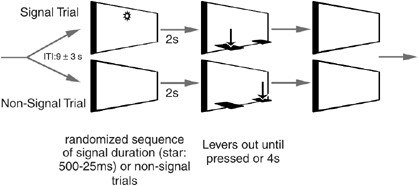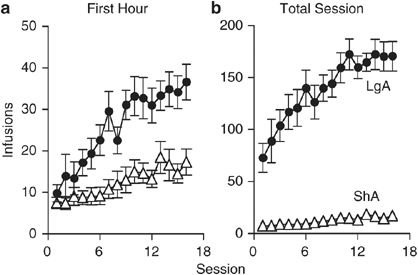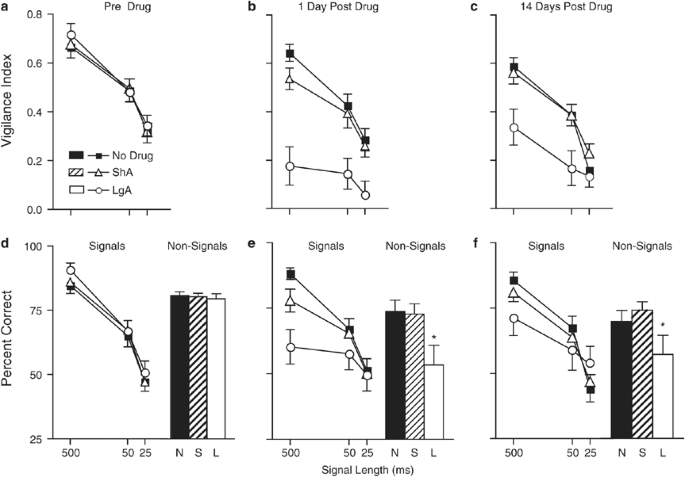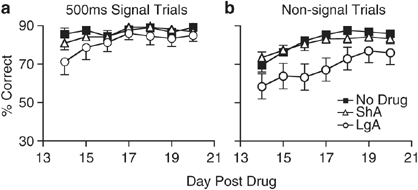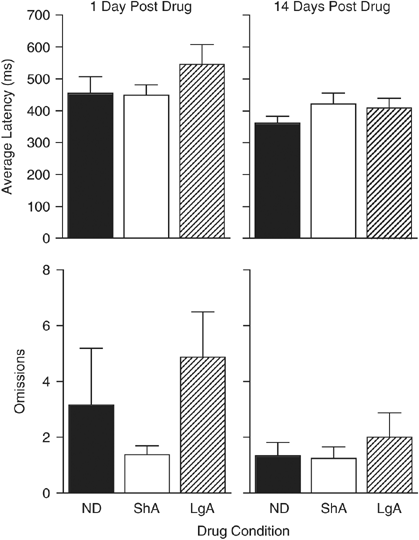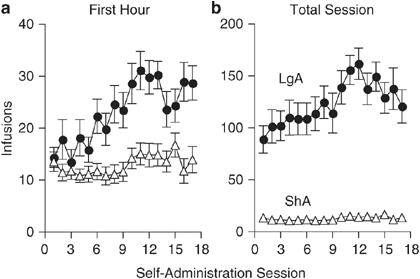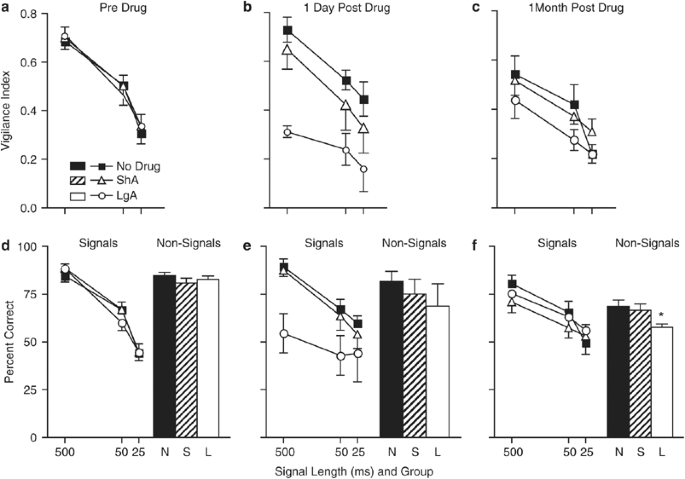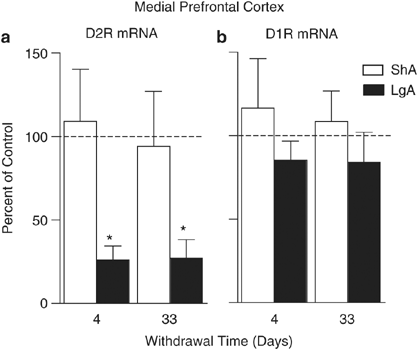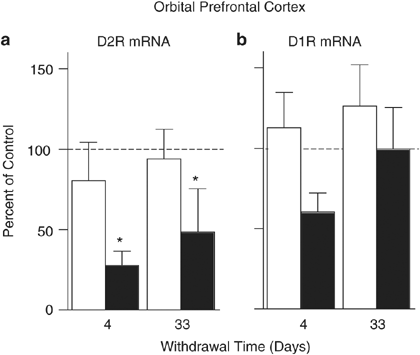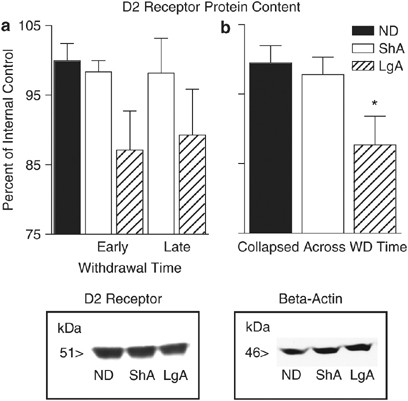Persistent Alterations in Cognitive Function and Prefrontal Dopamine D2 Receptors Following Extended, but Not Limited, Access to Self-Administered Cocaine (original) (raw)
INTRODUCTION
Cocaine addicts have deficits in cognitive function, including deficits on tests of short-term memory, attentional control, and decision-making, and these are evident even long after the discontinuation of drug use (Miller, 1985; Hoff et al, 1996; Rosselli and Ardila, 1996; Bolla et al, 1999). Many of these cognitive functions are known to require the prefrontal cortex, and structural and functional imaging studies suggest that indeed, prefrontal cortical function is impaired in addicts (Volkow et al, 1988, 1991; Goldman-Rakic, 1995; Robbins, 1996; Bolla et al, 1998, 2003, 2004; Liu et al, 1998; Ernst et al, 2002; Matochik et al, 2003; Kosten et al, 2006). It is not clear, however, whether these behavioral and neurobiological deficits precede drug use, and thus potentially contribute to the propensity for addiction, or are a consequence of drug use. It is difficult to address this issue in humans, but studies with non-human animals allow one to determine whether exposure to a drug of abuse is capable of producing changes in brain and behavior comparable to those seen in addicts.
Studies using non-human animals have shown that when psychostimulant drugs are administered by an experimenter, they can produce both acute and persistent deficits in cognitive function (Crider et al, 1982; Jentsch et al, 2002; Kondrad and Burk, 2004; Schoenbaum et al, 2004; Burke et al, 2006). For example, Schoenbaum et al (2004) reported that experimenter-administered cocaine produces persistent reversal deficits on an odor discrimination task mediated by the orbital frontal cortex in rats, and similar deficits have been seen in non-human primates (Jentsch et al, 2002). However, with one exception (Calu et al, 2007), experiments in which animals were allowed to self-administer cocaine have not resulted in persistent cognitive deficits. The self-administration of psychostimulant drugs is reported to produce cognitive deficits during the period of acute withdrawal, for a few days after the discontinuation of drug treatment, but these do not persist unless animals are given an additional drug challenge (Crider et al, 1982; Kondrad and Burk, 2004; Dalley et al, 2005a, 2005b; Kantak et al, 2005). The absence of persistent deficits following cocaine self-administration in some studies may be due to the cognitive tasks utilized, or alternatively, the self-administration procedures used may not accurately model the addictive state.
Preclinical studies involving self-administration have largely used limited-access procedures (Dalley et al, 2005a, 2005b; Kantak et al, 2005), but these may not produce some of the key changes in brain and behavior that characterize addiction. Recent reports suggest that extended access procedures are required to produce many symptoms characteristic of addiction, including escalation of drug intake (Ahmed and Koob, 1998; Deroche-Gamonet et al, 2004; Vanderschuren and Everitt, 2004; Ferrario et al, 2005). We hypothesized, therefore, that extended (but not limited) access to self-administered cocaine may produce persistent deficits on a demanding task that probes attentional processes, and associated changes in prefrontal cortical dopamine function.
Our focus on the long-term consequences of self-administered cocaine specifically on attentional functions is based on evidence indicating marked impairments in attentional processes in psychostimulant abusers (eg, Ornstein et al, 2000; Goldstein et al, 2007), and on the view that persistent impairments in attentional processes and capacities fundamentally contribute to, or even underlie, deficits in executive functions (eg, Posner and Rothbart, 2007; Sarter and Lustig, 2007)—deficits that are thought to contribute to addiction (Rogers et al, 1999). Furthermore, repeated (experimenter administered) amphetamine treatment has been shown to disrupt attentional performance on a task very similar to that employed here (Martinez et al, 2005; Kozak et al, 2007), indicating that the task should be adequately sensitive.
MATERIALS AND METHODS
Subjects
One hundred and thirty-eight male Wistar rats (Harlan, Indianapolis, IL) weighing 200–225 g at the start of the experiment were individually housed in square plastic hanging cages (8 × 9 × 8 cm). The animals were housed in a temperature and humidity controlled room with a 14:10-h light/dark cycle, with water available ad libitum. Animals were food restricted throughout the experiment to maintain at least 90% of their free feeding body weight. All procedures were approved by the University of Michigan Committee on the Use and Care of Animals (UCUCA).
Apparatus
Behavioral training, testing, and drug administration took place in 16 operant chambers measuring 22 × 18 × 13 cm (Med Associates, St Albans, VT) located inside larger sound-attenuating chambers. For the sustained attention task, each operant chamber was equipped with a panel consisting of one light (2.8 W), two retractable levers, and a food pellet dispenser, all located on the front wall. A house light (2.8 W) was located close to the ceiling of the back wall. The floor of the chamber consisted of 19 stainless steel rods (4 mm in diameter) spaced 1.5 cm apart (center-to-center). For the drug self-administration procedure, each operant chamber had two nose-poke holes equipped with cue lights. A tone (2900 Hz) was also available inside the chamber. The floor of the chamber consisted of a solid piece of black plastic placed over the stainless steel rods. Med-PC for Windows software (v. 1.1; Med Associates) controlled all signal presentation, lever operation, pellet delivery, drug delivery, tone presentation, and data collection via a Pentium PC.
Experiment I: Within-Subject Study
Sustained attention task training
For a detailed description of sustained attention procedures, see McGaughy and Sarter (1995). The task required four phases of training. Phase I: All animals were shaped to lever press for food (45-mg banana-flavored pellet; Bioserv, Frenchtown, NJ) using a fixed-ratio 1 (FR1) schedule such that one lever press resulted in the delivery of one food pellet. During this stage, both the levers were extended into the box at the beginning of each session and remained extended for the entire session. Training continued until the animals had at least three days of 120 reinforced lever presses. Phase II: After reaching this criterion, rats were then shaped to discriminate between signals (illumination of the central signal light for a period of 1 s) and non-signals (no illumination). For this training phase, the start of each individual trial was indicated by the extension of both levers into the box. Response on one lever was reinforced if it followed a signal, while response on the other lever was reinforced if it followed a non-signal. The assignment of levers was counter-balanced across subjects to minimize side bias. To increase the salience of the signal light and facilitate acquisition of the appropriate response, the house light was not illuminated during this training step. Signal and non-signal trials were presented pseudo-randomly with a mean inter-trial interval of 9±3 s. Four responses were possible during this second phase of training: hit, defined as the correct response to a signal; miss, the incorrect response to a signal; correct rejection, the correct response to a non-signal; and false alarm, the erroneous response to a non-signal (ie, a claim for a signal following a non-signal; see Figure 1 for a schematic representation). If the animal responded incorrectly, the previous trial was repeated up to three times. If a rat continued to respond incorrectly, it received a forced-choice trial in which only the correct lever was extended into the box while the signal was presented. Forced-choice trials also served to impede the generation of a side bias. Trials in which the rats failed to emit a response within 4 s of lever insertions were counted as omissions. Animals reached criterion for this portion of training when they responded correctly to 65% of the signal and non-signal trials for five consecutive days. Phase III: The 1-s signal was replaced with three different signal lengths of 500, 50, and 25 ms, equally distributed across the session. Following a correct response to 65% of the 500 ms and non-signal trials, the final stage of training began. Phase IV: During the final stage of training, the house light was illuminated; this is a critical step in the acquisition of the sustained attention task as it forces animals to limit competitive behaviors and to closely monitor the intelligence panel in order to detect signal events. The final task consisted of three blocks of 54 trials, with nine trials of each signal length and 27 non-signal trials. The signal and non-signal trials were pseudo-randomized. Animals reached criterion when their performance became asymptotic at a level of at least 70% hits on the longest (500 ms) signal length trials, 70% correct rejections on the non-signal trials, and less than 30% omissions.
Figure 1
Schematic illustration of the of the sustained attention task. Correct responses on signal trials (hits) and non-signal trials (correct rejections) were rewarded (arrows) and incorrect responses (misses and false alarms, respectively) were not.
Surgical procedures
Individual animals reached performance criterion on the sustained attention task at different rates, and therefore cocaine self-administration and subsequent attention testing occurred at different times for each animal. After reaching criterion on the attention task, animals were anaesthetized with ketamine and xylazine anesthesia (77:1.5 mg/ml, intraperitoneally at 0.1 ml/100 g of body weight) and a silicone catheter (Plastics One, Roanoke, VA) was inserted into the right jugular vein and passed subcutaneously to exit from the animals’ back (see Caine et al, 1993). Animals were allowed to recover from surgery for a minimum of 3 days prior to drug administration. Catheters were flushed daily with 0.1 ml of gentamicin (50 mg/kg, in 0.9% sterile bacteriostatic saline).
Cocaine self-administration
Rats were transported from their home cage to an operant chamber 6 days a week for 4 weeks, where they were allowed to nose-poke for cocaine (0.4 mg/kg per infusion in 50 μl of saline administered over 1.6 s) on a continuous reinforcement schedule (FR1) with a time-out of 20 s. A training session commenced with the illumination of the ‘active’ nose-poke hole stimulus light. Responding in this hole resulted in drug delivery. Responding in the other nose-poke hole, designated inactive, had no consequences. Rats were initially trained during daily 1-h sessions for a total of 6 days. Animals not acquiring stable self-administration behavior (at least 5 infusions each day for 3 consecutive days) were removed from the study. After the initial 6-day training period, animals were grouped as follows: a long-access (LgA) group and a short-access (ShA) group. These groups were balanced according to both the amount of drug they administered during the first week of training and their performance during attention training. Animals in the ShA group continued to receive 1-h test sessions, whereas animals in the LgA group received 6-h test sessions for an additional 16–17 sessions. A third group of rats (no-drug (ND) control group) received sham surgery and were transported each day to a novel test room where they were placed into Plexiglas chambers, similar to the operant chambers.
Sustained attention testing
One day following 4 weeks of drug self-administration (or transport in the ND control groups), animals were retested on the sustained attention task (_n_=12–16). Animals were tested again 2 weeks after the last self-administration session, followed by daily retraining for 1 week following the test on day 14.
Experiment II: Between-Subject Study
Experiment II utilized a between-subject design to control for potentially confounding effects of repeated testing on the performance on the attention task in experiment I. This study also examined performance on the sustained attention task 1 month after the last self-administration session to determine the persistence of any drug-induced cognitive deficits. Along with the behavioral analysis, experiment II was also designed to examine changes in the expression of dopamine D1 and D2 receptor mRNA in the prefrontal cortex.
The methods for sustained attention task training and drug self-administration were identical to those in experiment I.
Sustained attention testing
Following completion of self-administration, animals in the ND, ShA, and LgA groups were divided into two more groups. One group (_n_=5–6) was tested on the attention task 1 day following the last self-administration session and another independent group (_n_=6–8) was tested 30 days following the last self-administration session.
Tissue collection
Three days following their respective sustained attention-testing session (at days 4 and 33 following the last self-administration session), all animals were decapitated and their brains were removed and frozen in isopentane (−40 to −50°C) on dry ice. The brains were then stored at −80°C. Coronal brain sections (10 μm) were cut on a cryostat at 200-μm intervals, thaw mounted on Superfrost/Plus slides (4 sections per slide, Fisher Scientific, Pittsburgh, PA) and stored at −80°C until further processing.
In situ hybridization
For detailed methodology of the in situ hybridization techniques used, see Kabbaj et al (2000). Following fixation, sections were hybridized with 35S-labeled cRNA probes produced using standard in vitro transcription methodology. Prefrontal cortical sections were processed for in situ hybridization of dopamine D1 and D2 receptor mRNA (480-mer). The probes were diluted in hybridization buffer and slides were coverslipped and incubated overnight at 55°C. Following rinses and dehydration, slides were exposed to X-ray film (Kodak Biomax-MR; Eastman Kodak, Rochester, NY) for 2 weeks. The specificity of the hybridization signal was confirmed with sense probe controls (data not shown).
Quantification
Autoradiographs were digitized using a Scanmaker 1000XL scanner (Microtek, Carson, CA) and the magnitude of the signal of the radioactive probes was determined using Scion Image (Scion Corporation, Frederick, MD). A macro was used to automatically determine signal above background in each brain region (written by Dr S Campeau, University of Colorado, Boulder, CO). A background value was obtained from a white-matter region such as the corpus callosum in each section and only values exceeding the background by 3.5 times the standard deviation were included in the analysis. Results are expressed as the mean integrated density of signal pixels divided by the total number of pixels in the selected region. The person quantifying was blind to group assignments. Anatomical regions were identified and subdivided for densitometric analysis according to the stereotaxic atlas of (Paxinos and Watson, 1998). More specifically, the medial prefrontal cortex included the cingulate, prelimbic, and infralimbic sub-regions of the frontal cortex at 2.7 mm anterior from bregma, as defined by Paxinos and Watson (1998). The orbital frontal cortex included the medial, lateral, and ventral sub-regions, at 4.2 mm anterior to bregma, as defined by Paxinos and Watson (1998).
Experiment III: D2 Receptor Protein
Experiment III was designed to examine the effects of limited vs extended access to self-administered cocaine on levels of DA D1 and D2 receptor protein in the prefrontal cortex. The methods for drug self-administration were identical to those in experiment I.
Tissue collection and sample preparation
A total of 3 or 30 days following their final self-administration session, animals were decapitated and their brains removed. The entire prefrontal cortex was dissected, fast frozen on dry ice, and kept at −80°C until further processing. Frozen brain tissue was homogenized (1:10, w/v) in cold 50 mM Tris-HCl buffer, pH 6.8, containing 2% SDS, 1 mM EDTA, and various protease inhibitors as previously reported (Garcia-Fuster et al, 2007). Aliquots of total homogenate were mixed with equal volumes of electrophoresis loading buffer, denatured, and stored at –20°C until use. Protein concentrations were determined by the BCA Protein Assay reagent (Pierce Biotechnology, Rockford, IL).
Western blot analysis
For western blot analysis, 33 μg of each protein sample (determined to be within the linear range for immunoblotting of D1DR and D2DR) were separated by electrophoresis on 10% acrylamide/bisacrylamide minigels and transferred electrophoretically to nitrocellulose membranes. The membranes were subsequently blocked for 1 h at room temperature in phosphate-buffered saline (PBS (in mM): 137 NaCl, 2.68 KCl, 10.14 Na2HPO4, 1.76 KH2PO4) containing 0.2% Tween-20, 0.5% bovine serum albumin, and 5% non-fat dry milk. Incubation with the primary antibodies (mouse anti-dopamine D2 receptor, 1:400 dilution; Santa Cruz Biotechnology Inc., Santa Cruz, CA; mouse anti-dopamine D1 receptor, 1:1000 dilution; Santa Cruz Biotechnology Inc.; mouse anti-_β_-actin, 1:10 000 dilution; Sigma-Adrich, St Louis, MO) was performed overnight at 4°C. After extensive washing in PBS, the membranes were incubated with the secondary antibody, horseradish peroxidase-linked anti-mouse IgG (1:5000 dilution), in blocking solution at room temperature for 1 h. Immunoreactivity of target proteins was detected with the ECL Western Blot Detection system (Amersham International, Buckinghamshire, UK) and visualized by exposure to Hyperfilm ECL film (Amersham) for 60 s to 60 min. The autoradiograms were then quantified by densitometric scanning (IOD) using Image J software. Each protein sample was run on 3–4 gels and an average value for each animal was calculated. The amount of target protein in brain samples of treated rats was compared with an internal control sample in the same gel composed of prefrontal cortices from three control rats that had not received any treatment. This internal control was run thrice on each gel and an average was calculated for comparison with other samples on that gel. Finally, percent changes in immunoreactivity with respect to internal controls (100%) were calculated for each sample in each of the various gels. In all the experiments the content of _β_-actin, a cytoskeletal protein not altered in brain by cocaine treatments (Imam et al, 2005), was quantified as a loading control.
Statistical Analyses
Cocaine self-administration
The number of infusions for the first hour of each session and for the entirety of the session was determined for each day of self-administration. Two-way repeated measures ANOVAs were performed with escalation session (1–16) as the repeated variable, drug group (ShA, LgA) as the independent variable and first hour or total infusions as the dependent variable. For all analyses, α was set at 0.05.
Sustained attention
For each sustained attention session, the number of hits, misses, correct rejections, false alarms, and omissions was calculated. To examine each animal's accuracy on the task, the relative number of hits (hits/(hits+misses)) for each signal length, and the relative number of correct rejections (correct rejections/(correct rejections+false alarms)) were calculated. In addition the vigilance index (VI), an overall measure of sustained attention performance, was calculated using the relative number of hits (h) and false alarms (fa) with the following formula: VI=(h−fa)/(2(h+fa)−(h+fa)2). This index is similar to sensitivity index (Frey and Colliver, 1973), except that omitted trials are excluded from the calculation. VI provides a sensitive measure of overall performance, taking into account both trial types; VI varies between 1 and −1, with 1 indicating that all responses were hits and correct rejections, 0 that responses were randomly distributed over the four response types (hits, misses, false alarms, correct rejections), and −1 that all responses were misses and false alarms. Performance on each of the trial types (signal vs non-signal) was also examined to reveal the specific responses contributing to the overall deficits. Two-way ANOVAs were performed with withdrawal day (1 or 30) and drug group (ND, ShA, LgA) as the independent variables and VI or the relative number of hits or correct rejections as the dependent variables. When significant main effects or interactions were revealed, individual group comparisons were made using either additional ANOVAs, or Fisher's post hoc tests.
Gene expression
The levels of mRNA in the experimental groups were expressed as a percent of the mean value for the control group. Group differences in gene expression were assessed using two-way ANOVAs with withdrawal time (4 or 33 days) and drug group (ND, ShA, LgA) as independent variables and percent of control mRNA levels as dependent variable. Fisher's post hoc comparisons were conducted when main effects or interactions were present.
Western blot analysis
The levels of D1 and D2 receptor protein were expressed as percent of internal control values for each individual gel (see above). Group differences in protein expression were assessed using a two-way ANOVA with withdrawal time (3 or 30 days) and drug group (ND, ShA, LgA) as independent variables and percent of control protein levels as dependent variable.
RESULTS
Experiment I: Within-Subject Study
Cocaine self-administration
Following the initial 6-day training period ShA, animals continued with 1-h self-administration sessions and LgA animals were given 6-h daily sessions. When examining the number of infusions taken during the first hour of each of these sessions (Figure 2a), both the ShA (one-way ANOVA, day, F(15, 240)=1.86, _p_=0.03) and LgA groups (day, F(15, 224)=4.89, p<0.0001) animals increased their cocaine intake over time. However, the effect was much greater in the LgA group than in the ShA group, as indicated by a significant group by time interaction (main effect of group, F(1, 15)=16.49, _p_=0.0003; main effect of day, F(15, 435)=12.87, p<0.0001; group by day interaction, F(15, 435)=2.90, _p_=0.0002). In addition, LgA animals exhibited a significant increase in the number of infusions over the entire session over the course of self-administration (Figure 2b).
Figure 2
(a) Mean (±SEM) number of cocaine infusions during the first hour of each self-administration session in experiment I. Both the ShA (1-h sessions) and the LgA (6 h sessions) groups increased their intake over time, but this effect was significantly greater in the LgA group than in the ShA group. (b) Mean (±SEM) number of cocaine infusions over the entire session for LgA and ShA groups.
Sustained attention performance
Animals were trained on the sustained attention task for approximately 8 weeks prior to drug self-administration and animals assigned to the LgA, ShA, and ND groups were matched on the basis of training performance (Figure 3a and d). Twenty-four hours following the final self-administration session, animals in the LgA group were markedly impaired on the sustained attention task, as illustrated by a significant decrease in VI relative to ND controls. In contrast, the ShA group did not differ from control (overall ANOVA, main effect of group, comparing all groups, F(2, 80)=11.49, _p_=0.0001; group by signal length interaction, F(4, 80)=5.68, _p_=0.0004; individual group comparisons: LgA vs ND, group, F(1, 50)=17.13, _p_=0.0003; interaction, F(2, 50)=11.59, p<0.0001; LgA vs ShA, group, F(1, 58)=12.56, _p_=0.0014; interaction, F(2, 58)=4.36, _p_=0.0172; Figure 3b). At this point in time, the performance of animals in the LgA group was impaired with respect to their ability to detect signals as well as to respond correctly to non-signal events (signal trials overall ANOVA, interaction, F(4, 90)=6.92, p<0.0001; individual group comparisons: LgA vs ND, F(2, 50)=13.57, p<0.0001; LgA vs ShA, F(2, 58)=5.37, _p_=0.007; non-signal trials ANOVA, F(2, 40)=4.28, _p_=0.02; *differs from ShA and ND groups as determined by Fisher's tests; Figure 3e). Fourteen days following the last self-administration session, the LgA animals were still impaired relative to the control group, as indicated by a significant decrease in VI (overall ANOVA, group, F(2, 80)=4.78, _p_=0.01; interaction, F(4, 80)=4.28, _p_=0.004; individual group comparisons: LgA vs ND, group, F(1, 50)=5.48, _p_=0.028; LgA vs ShA, group, F(1, 58)=5.69, _p_=0.016; Figure 3c). However, by 14 days of withdrawal, the deficit was due primarily to an increase in the number of false alarms (‘claims’ for signals on non-signal trials), as there was no longer a significant effect of prior self-administration on signal trial performance.
Figure 3
The effect of extended vs limited access to self-administered cocaine on performance on the sustained attention task as a function of time following the last self-administration session. The top three panels show the data expressed as a VI, which provides an overall index of performance incorporating both signal and non-signal trials (see MATERIALS AND METHODS). The bottom three panels show the percent correct responses for signal trials (as a function of signal duration; line graph) and non-signal trials (bar graph) separately. The panels on the left (a, d) show performance on the last day of training, prior to any cocaine self-administration experience, in the animals that will eventually be given limited (ShA) or extended (LgA) access to cocaine, or no treatment (ND). The groups were balanced to equate performance at the end of training, so there are no group differences on any measure at this point in time. The panels in the middle (b, e) show performance one day following the final self-administration session. (b) At this time there was a significant decrease in VI in the LgA group relative to both the ND and ShA groups, which did not differ from one another. (e) The LgA group performed more poorly than either the ShA or ND groups on both signal and non-signal trials, and the ShA and ND groups did not differ from one another on either trial type (*differs from ShA and ND groups as determined by Fisher's Tests). The panels on the right (c, f) show performance when the same animals were retested 14 days following the final self-administration session. (c) At this time there was still a significant decrease in VI in the LgA group, relative to both the ND and ShA groups. However, by this time the deficit was primarily a function of impaired performance on non-signal trials (see f; *differs from ShA and ND groups as determined by Fisher's tests).
Following the test on day 14, animals were tested daily for an additional 7 days. Throughout this retraining period, there were no group differences on signal trials, that is, in the relative number of hits (Figure 4a). However, the LgA group continued to show a significant deficit on non-signal trials relative to the control and ShA groups throughout this period (overall ANOVA, group, F(2, 240)=3.80, _p_=0.03; individual group comparisons: LgA vs ND, group, F(1, 150)=4.15, _p_=0.05; LgA vs ShA, group, F(1, 174)=4.1, _p_=0.05; Figure 4b). It is important to note that there were no group differences in either response latencies or the number of omissions at any point in time, indicating that all animals were equally motivated to perform the task (Figure 5).
Figure 4
The effect of 1 week of ‘retraining’ on the sustained attention task beginning 14 days after the last self-administration session. Data are shown as percent correct responses (a) on signal trials in which the signal duration was 500 ms and (b) on non-signal trials. There were no group differences on signal trials over this period of time. However, on non-signal trials the LgA group showed significantly fewer correct responses than either of the other two groups.
Figure 5
The effect of extended vs limited access to self-administered cocaine on response latency and omission rate (mean±SEM) as a function of time following the last self-administration session in experiment I. There were no group differences on either measure on either day.
Experiment II: Between-Subject Study
Cocaine self-administration
As in experiment I, ShA and LgA groups were balanced to match drug intake during the initial 6-day self-administration training period and ShA animals continued with 1-h self-administration sessions and LgA animals were given 6-h daily sessions for 3 weeks. When examining the number of infusions taken during the first hour of each of these sessions (Figure 6a), LgA animals showed a progressive increase in intake over time (main effect of drug condition, F(1, 768)=19.92, p<0.0001; main effect of day, F(16, 768)=6.05, p<0.0001; interaction, F(16, 768)=3.11, p<0.0001; pairwise comparisons, p<0.05 (LgA vs ShA, days 8–17)). In addition, the LgA animals exhibit a significant increase in the number of infusions over the entire session over the course of self-administration (Figure 6b). In this experiment, there was no significant change in drug intake in the ShA group over days of testing (one-way ANOVA, day, F(16, 340)=0.64, _p_=0.85; Figure 6).
Figure 6
(a) Mean (±SEM) number of cocaine infusions during the first hour of each self-administration session in experiment II. The LgA group significantly increased their intake over time, but there were no significant changes in cocaine intake over time in the ShA group. (b) Mean (±SEM) number of cocaine infusions over the entire session for LgA and ShA groups.
Sustained attention performance
All groups were balanced on the basis of their attention training performance (Figure 7a and d). As in experiment 1, when tested 24 h after the final self-administration session, animals in the LgA group were markedly impaired on the sustained attention task, as indicated by a significant decrease in VI (overall ANOVA, group, F(2, 26)=6.06, _p_=0.01; individual group comparisons: LgA vs ND, group, F(1, 16)=32.49, _p_=0.0005; LgA vs ShA, group, F(1, 18)=4.1, _p_=0.05; Figure 7b). This was due to a decrease in performance on both signal and non-signal trials, although only the effect on signal trials was statistically significant (overall ANOVA, group, F(2, 39)=5.6, _p_=0.007; individual group comparisons: LgA vs ND, group, F(1, 24)=7.7, _p_=0.01; LgA vs ShA, group, F(1, 27)=5.4, _p_=0.028; Figure 7e). The absence of a significant effect on non-signal trials, as seen in experiment I, was probably due to a lack of power because a relatively small number of animals were tested at this time point. A larger independent group of LgA animals was tested 30 days after the last self-administration session, and these animals were significantly impaired on non-signal but not signal trials (overall ANOVA, F(2, 29)=3.37, _p_=0.04; Figure 7f). There were no differences between the ShA and control groups at either point in time. Also, as in experiment I, the LgA group did not differ from controls in either response latencies or rate of omissions at either time point examined (data not shown).
Figure 7
The effect of extended vs limited access to self-administered cocaine on performance on the sustained attention task as a function of time following the last self-administration session in experiment II. The data are presented as described for Figure 3. The panels on the left (a, d) show performance on the last day of training, prior to any cocaine self-administration experience, in the animals that will eventually be given limited (ShA) or extended (LgA) access to cocaine, or no treatment (ND). As in experiment I, there was a significant decrease in VI in the LgA group relative to both the ND and ShA groups when animals were tested 1 day after the last self-administration session, and the latter two groups did not differ from one another (b). The LgA group made significantly fewer correct responses on signal trials, but the effect on non-signal trials was not statistically significant, presumably because a relatively small number of animals were tested on this day (e). The panels on the right (c, f) show the performance of an independent group of animals tested for the first time 30 days following the final self-administration session. At this time, there were no significant group differences on VI. (f) As in experiment I, when tested long after the last self-administration session, the LgA group was not impaired in their performance on signal trials, but was impaired on non-signal trials (*differs from ShA and ND groups as determined by Fisher's tests).
Influence of instrumental experience
In experiments I and II, the LgA group spent 6 h per day actively engaged in an operant task during the 4 week self-administration period, whereas the ShA group only spent 1 h per day and the ND animals none. It is possible, therefore, that group differences in time spent performing this instrumental response could in some way have contributed to group differences in performance when the animals were retested on the sustained attention task. To address this issue, we conducted a separate control experiment in which rats were given extended experience (3 weeks), making a similar instrumental response (nose-poking for a food reward), and then 24 h later retested on the sustained attention task. There was no effect of 3 weeks of training on a food-rewarded instrumental task (relative to controls that did not work for food) when animals were re-exposed to the sustained attention task 24 h following the last session of instrumental training (data not shown). We conclude, therefore, that group differences in the time spent simply making an instrumental response during the self-administration phase of experiments I and II were not responsible for the subsequent group differences in performance on the sustained attention task.
Dopamine receptor mRNA expression in the prefrontal cortex
Brains were obtained for in situ hybridization histochemistry 3 days after the final test on the sustained attention task, which for one group was 4 days and for the other group 33 days following the last self-administration session. We quantified DA receptor mRNA expression in the two main sub-regions of the prefrontal cortex, the medial prefrontal cortex (cingulate, prelimbic, and infralimbic cortices), and the orbitofrontal cortex (medial, ventral, and lateral orbital cortices), as defined by Paxinos and Watson (1998). Medial Prefrontal Cortex: There were no differences between the control and ShA groups in D2 mRNA expression in the medial prefrontal cortex at either time point (Figure 8a). In contrast, relative to the control group, the LgA animals showed a significant decrease in D2 mRNA expression in the medial prefrontal cortex, which was evident at both 4 and 33 days after the last self-administration session (overall ANOVA, group, F(2, 24)=3.87, _p_=0.03; individual group comparisons: LgA vs ND, group, F(1, 15)=6.94, _p_=0.02: LgA vs ShA, group, F(1, 16)=7.99, _p_=0.01; Figure 8a). There were no group differences in levels of D1 receptor mRNA in the medial prefrontal cortex (Figure 8b). Orbitofrontal Cortex: As in the medial prefrontal cortex, the LgA group (but not the ShA group) exhibited a decrease in D2 receptor mRNA in the orbitofrontal cortex at both withdrawal times (D2 overall ANOVA, group, F(2, 22)=3.48, _p_=0.05; individual group comparisons: LgA vs ND, group, F(1, 14)=5.66, _p_=0.03; LgA vs ShA, group, F(1, 15)=5.97, _p_=0.03; Figure 9a) and no alterations in D1 receptor mRNA expression (Figure 9).
Figure 8
Dopamine D2 receptor (a) and D1 receptor (b) mRNA expression in the medial prefrontal cortex of rats allowed extended (LgA) or limited (ShA) access to self-administered cocaine, and then examined either 4 or 33 days after the last self-administration session. The data represent mean (+SEM) levels of mRNA in the LgA and ShA groups expressed as a percent of the average amount of mRNA in the ND control group (represented by the horizontal dashed lines). The LgA group showed a significant decrease in D2 receptor mRNA expression, relative to both the ND control group and the ShA group, which did not differ from one another (*differs from ShA and ND groups). There were no group differences in D1 mRNA expression in the medial prefrontal cortex.
Figure 9
Dopamine D2 receptor (a) and D1 receptor (b) mRNA expression in the orbital prefrontal cortex of rats allowed extended (LgA) or limited (ShA) access to self-administered cocaine, and then examined either 4 or 33 days after the last self-administration session. The data represent mean (+SEM) levels of mRNA in the LgA and ShA groups expressed as a percent of the average amount of mRNA in the ND control group (indicated by horizontal dashed lines). The LgA group showed significant decrease in D2 receptor mRNA expression in the orbitofrontal cortex relative to both the ShA and control animals at both withdrawal time points. There were no significant group differences in D1 receptor mRNA expression.
Brain behavior correlations
Correlational analyses were used to examine the relationship between sustained attention performance and dopamine receptor mRNA levels. VI score was used to take into account both trial types in the attention task. There was significant positive correlation between performance and D2 receptor mRNA levels in the prefrontal cortex (_r_=0.36, _p_=0.05; data not shown). There were no significant correlations between D1 mRNA expression and performance.
Experiment III: Dopamine Receptor Protein in the Medial Prefrontal Cortex
Cocaine self-administration
As in experiments I and II, ShA and LgA groups were balanced to match drug intake during the initial 6-day self-administration training period. Animals allowed extended access to cocaine showed a progressive increase in both their total intake and their intake during the first hour of each session (main effect of drug condition, F(1, 476)=64.24, p<0.0001; main effect of day, F(17, 476)=6.61, p<0.0001; interaction, F(17, 476)=6.97, p<0.0001; pairwise comparisons, p<0.05 (LgA vs ShA; escalation days 7–18). As in experiment II, the ShA group did not significantly change drug intake over time (one-way ANOVA, day, F(17, 270)=1.57, _p_=0.07). These data are similar to those described in experiments I (Figure 2) and II (Figure 6) and are therefore not shown.
Western blot analysis
Analysis of the amount of D2 receptor protein in the prefrontal cortex resulted in a significant main effect of group but no effect of time or a group by time interaction (overall ANOVA, group, F(2, 42)=4.08, _p_=0.02: withdrawal time, NS; interaction, NS; see Figure 10). Further analysis indicated that this was because the LgA group showed a small but statistically significant decrease in D2 receptor protein relative to the Control and ShA groups, which did not differ from one another (individual group comparisons: LgA vs ND, group, F(1, 28)=6.71, _p_=0.02; LgA vs ShA, group, F(1, 25)=4.34, _p_=0.05). There were no group differences in the amount of D1 receptor protein in the prefrontal cortex (data not shown).
Figure 10
Dopamine D2 receptor protein levels in the medial prefrontal cortex of rats allowed extended (LgA), limited (ShA), or no (ND) access to self-administered cocaine examined either 3 or 30 days after the last self-administration session. The data represent mean (±SEM) of D2 receptor protein levels relative to an internal control. The LgA group showed significant decrease in D2 receptor protein levels, relative to both the ND control group and the ShA group, which did not differ from one another (a). As there was a significant effect of group, but no effect of withdrawal time and no group by time interaction, the data were collapsed across the two time points to demonstrate that the group effect is due to a decrease in LgA group (b); *differs from ShA and ND groups. No group differences were seen in a _β_-actin control.
DISCUSSION
Effects of Past Experience with Self-Administered Cocaine on Cognitive Function
The day after the discontinuation of cocaine self-administration, during acute withdrawal, animals that had extended access to self-administered cocaine (LgA) had a profound deficit on the sustained attention task, as indicated by a large decrease in the VI, and by impairments on both signal and non-signal trials. In contrast, animals that had limited access to cocaine (ShA) showed no deficits. With time (within 14 days) performance on signal trials recovered in the LgA group. However, the deficit on non-signal trials persisted for at least 30 days. Experimenter-administered cocaine has been reported to produce persistent cognitive deficits in both rats (Schoenbaum et al, 2004; Burke et al, 2006) and monkeys (Jentsch et al, 2002), but other than the present study, and a recent study by Calu et al (2007) showing persistent effects of self-administered cocaine on reversal learning, most studies utilizing cocaine self-administration procedures have not found evidence of persistent cognitive deficits.
It is not clear why evidence of persistent deficits in cognitive function following cocaine self-administration has been elusive. However, most previous studies involved limited-access procedures and it is possible that these do not produce some of the changes in brain and behavior characteristic of addiction. Indeed, accumulating evidence suggests that extended access to cocaine has a greater likelihood of producing a number of symptoms of addiction, relative to limited access, one of which is the tendency to escalate drug intake (Ahmed and Koob, 1998; Paterson and Markou, 2003; Deroche-Gamonet et al, 2004; Vanderschuren and Everitt, 2004; Ferrario et al, 2005). However, in one previous study, rats were allowed to self-administer a maximum of 150 injections of cocaine over 8 h, and these animals achieved a level of intake comparable to that of the LgA group here, but did not show persistent deficits on a five-choice serial reaction time task (Dalley et al, 2005a). There are at least two possible reasons for this. One, the self-administration procedure used by Dalley et al (2005a) may not have resulted in an escalation of drug intake or other changes in brain and behavior characteristic of addiction. However, a more likely reason is that in the five-choice serial reaction time task all trials are signal trials, in that animals are required to report the location of a brief visual stimulus. We also saw only a transient deficit on signal trials, and in this sense the results reported here are consistent with those reported by Dalley et al (2005a) (2005b).
In the present study, there was a persistent deficit only on non-signal trials, and therefore, it is important to consider how the cognitive demands of the task used here differ as a function of trial type, and what this might tell us about the nature of the deficit. First, it is important to emphasize that there were no group differences in omissions or response latencies in any of the experiments, suggesting that the animals were equally motivated to perform and did not suffer from obvious sensorimotor deficits. In contrast, in studies using the five-choice serial reaction time task, drug-treated animals did show a significant increase in omissions and response latencies, complicating interpretation of the nature of their deficit (Dalley et al, 2005a, 2005b). In addition, after the initial withdrawal period LgA animals’ signal trial performance was normal, suggesting that the deficits are not attributable to a failure to retrieve the rules governing the responses in the two types of trials. Nevertheless, on non-signal trials, the LgA animals generated an abnormally high number of false alarms, reporting a signal had occurred when it had not. Although more work is required to determine the exact nature of this deficit, the behavioral and cognitive operations underlying performance during non-signal trials certainly differ from those governing signal trials, and/or tasks that involve exclusively signal trials. On signal trials, the correct response is prompted by the presence of a visual stimulus and animals typically select the correct lever side and await lever insertion to respond. On non-signal trials, however, animals must first probe their memory as to whether or not a signal occurred before initiating an action. This may not only be more demanding in terms of taxing memory, but it also represents a more ambiguous situation, as the decision that a signal did not occur would be expected to be associated with high levels of uncertainty and therefore a reduced response criterion. Finally, performance on this task also taxes cognitive flexibility, which is required to shift constantly between the processing of the conflicting response rules governing the unpredictable occurrence of trials with or without signal events. Therefore, we hypothesize that prior cocaine use may have produced a persistent impairment in cognitive flexibility, which is required to respond correctly in trials involving high levels of uncertainty about signal status (see also Yu and Dayan 2005), while leaving the ability to respond correctly to a signal intact.
Effects of Past Experience with Self-Administered Cocaine on Brain Dopamine
Perhaps the most striking finding in the present study was that extended (but not limited) access to self-administered cocaine decreased dopamine D2 (but not D1) receptor mRNA expression in both the medial and orbital prefrontal cortices and this effect persisted for at least 33 days after the last self-administration session. Furthermore, there was a small but statistically significant decrease in the levels of D2 receptor protein in the prefrontal cortex of LgA but not ShA animals at both points in time after the last exposure to cocaine. There has been relatively little research on the long-term effects of cocaine on D2 receptors in the frontal cortex. However, Nogueira et al (2006) recently reported that experimenter-administered cocaine produces a persistent (2–4 weeks) decrease in ‘D2-mediated regulation of cortical excitability’ (Nogueira et al, 2006), which may be related to the alterations in D2 receptor mRNA and protein described here, and to the well-documented ‘hypofrontality’ seen in cocaine addicts (Bolla et al, 2003, 2004), and in animals treated repeatedly with cocaine (Sun and Rebec, 2005, 2006; Beveridge et al, 2006). The decreases in D2 receptor mRNA in the orbitofrontal cortex are particularly relevant in light of data demonstrating persistent deficits in reversal learning following cocaine administration, a task thought to be dependent on the orbitofrontal cortex (Schoenbaum et al, 2004; Calu et al, 2007).
These data suggest, therefore, that self-administered cocaine is capable of producing a marked and persistent dysregulation of dopamine function in the prefrontal cortex, which may represent another manifestation of marked frontal cortical dysfunction associated with cocaine addiction. Given that this effect was only seen in animals that received extended access to cocaine, it is possible that dysregulation of dopamine D2 receptor signaling contributes to the cognitive deficit, which was also only seen in the LgA group. The integrity of D2 receptor function is closely associated with the ability to manipulate acutely relevant information in prefrontal regions (Wang et al, 2004) and inhibition of D2 receptor activation in both humans and animals, either by antagonist administration or genetic manipulation, results in a decrease in the acquisition of working memory task rules (Glickstein et al, 2005), attentional set-shifting (Tost et al, 2006), and spatial working memory (Von Huben et al, 2006; Rinaldi et al, 2007). This is consistent with the idea that cocaine impaired cognitive flexibility primarily by disrupting prefrontal D2 receptor function. Finally, we found no effect of cocaine self-administration experience on D1 mRNA expression in the prefrontal cortex, consistent with the recent report that experimenter-administered cocaine has no effect on D1 receptor sensitivity in this region (Nogueira et al, 2006).
Although the decrease in D2 mRNA in medial prefrontal cortex was large (∼70%), the decrease in protein was much more modest (∼10%). Discrepancies between mRNA and protein levels are not uncommon (Mansour et al, 1990, 1991) and may be due to a number of different factors. For example, D2 receptor mRNA is localized primarily in the cell bodies of prefrontal neurons, but D2 receptor protein is present in both presynaptic and postsynaptic elements, and therefore the population of neurons sampled by the two measures may be quite different. More research is needed to determine whether the decreases seen in the current study are primarily due to changes in a specific cell type. It is also possible that rather than reflecting cell type specificity, the dissociation between mRNA and protein is due to alterations in the translation of mRNA into protein. Nevertheless, despite the difference in the magnitude of the effect of cocaine on mRNA vs protein, both were decreased, indicating a potential persistent dysregulation of D2 function in the prefrontal cortex of animals that had extended access to self-administered cocaine.
CONCLUSION
Extended, but not limited, access to self-administered cocaine produced a persistent deficit on a sustained attention task indicative of reduced cognitive flexibility, and this was accompanied by a persistent decrease in both dopamine D2 receptor mRNA expression and D2 protein levels in the medial prefrontal cortex, and of D2 mRNA in the orbitofrontal cortex. These findings are consistent with the hypothesis that similar deficits in brain and cognitive function seen in addicts may be a consequence of drug use, rather than just reflecting a premorbid condition. Furthermore, the fact that these changes in brain and behavior were only evident in animals allowed extended assess to self-administered cocaine suggests that this procedure may be especially valuable in studying the neurobiology of addiction.
